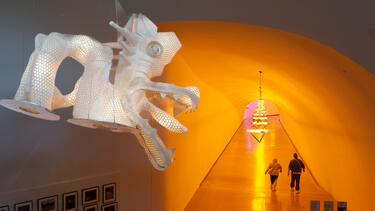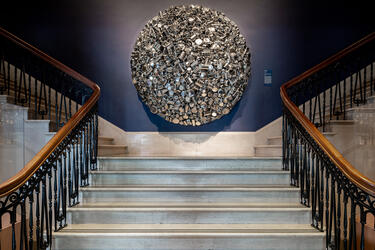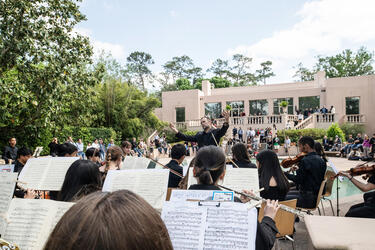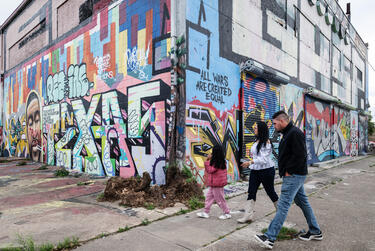Museum and Community: Connecting with a Diverse City
The Houston Museum of Art is one of the largest museums in the United States; it is also a local institution in the second-most-diverse large city in the country. Bradley Bailey ’10, the museum’s curator of Asian art, explains how the museum collaborates with immigrant communities to expand the understanding of Asian art.
A young man with a halo of dreads, wearing a stylish blazer, walks across the gray terrazzo lobby of the Museum of Fine Arts, Houston (MFAH); a friend, lost in his phone, stays in step beside him without looking up. Together they stop beside the wide stairs to the upper galleries and the man in the jacket watches a massive video screen, which displays William Forsythe’s installation “City of Abstracts.” At first glance, the screen seems to be a live feed of the lobby, but something is not quite right: the visitors around them are visible but the two men are missing. Just as their absence becomes unsettling, distorted forms—rippling ribbons—digitally duplicate their walk across the lobby.
When the ripples reach the stairs, they resolve into crisp video doppelgangers. Having witnessed this transformation, the man tentatively responds with a retro dance move. Seconds later, it appears on the screen. He nudges his friend to look up and together they observe themselves. Forsythe’s artwork has neatly embodied what all museums strive to achieve: give visitors something recognizable and compelling as a starting point for deeper discovery.
“When people encounter some aspect of their own identity, it’s a toehold,” says Gary Tinterow, director of the museum. “As they explore, whether they like it or not, whether they know it or not, they are being impacted by the experience.”
Anyone who has experienced a transcendent encounter with art knows the impact can be profound. Yet for many, a museum’s “don’t touch” atmosphere feels intimidating, and staring at artwork that leaves them cold can be frustrating. “There can be this sense of ‘I’m supposed to like this,’” says Bradley Bailey ’10, the MFAH’s Ting Tsung and Wei Fong Chao Curator of Asian Art.
Bailey works to ensure that the MFAH presents extraordinary artwork—and also avoids becoming an obligatory culture slog. “One of my strategies is to make installations look, in some way, like a retail environment, where people are very comfortable saying, ‘I love this so much’ or ‘I hate all of this.’ I want to encourage people to react however they react.”
The museum doesn’t charge admission on Thursdays, in order to ensure accessibility to everyone. “We’re executing a mission,” says Bailey. “But we can’t execute the mission if we can’t keep the lights on, so we have to balance things.” Through fundraising, sponsorships, and a myriad of other ways, the organization offsets costs for mission priorities.
“All the community outreach programs—of course they don’t make any money, but they’re important,” Bailey notes. Exhibitions that have scholarly significance or highlight a particular culture or period are worthwhile, he says, but they don’t always offer a return on investment. Still, the museum tries to find ways to do them. “The fact of the matter is that to pay for a very heady intellectual show, museums do exhibitions that you just know will have lines going out the door—Legos or fashion or the classic example is Tom Krens’s ‘The Art of the Motorcycle’ exhibition at the Guggenheim in 1998.”
When commercial exhibitions tour, the originator takes a percentage of ticket sales, but host museums have almost no costs. “And museums look at a constellation of revenue streams: catalog sales, induced spending in the cafes. And we know the gift shop is going to do numbers,” Bailey says.
The priorities were different for an exhibit of Zen painting. “I had the most awkward meeting with the retail team,” he remembers. “They asked, ‘What can we sell for the Zen Show?’ And I said, ‘I mean, ideally nothing. It’s an anti-materialism show.’”

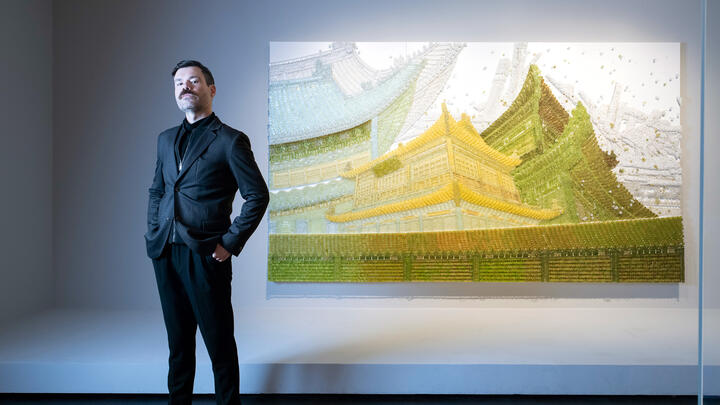

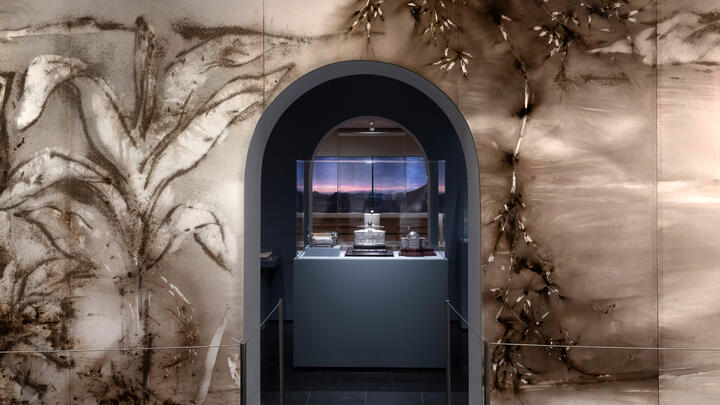
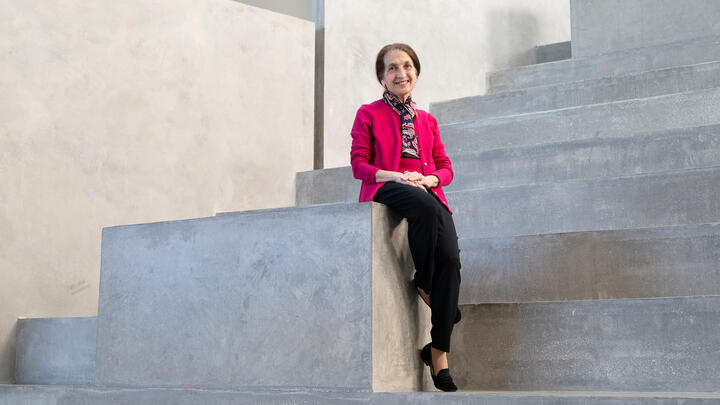
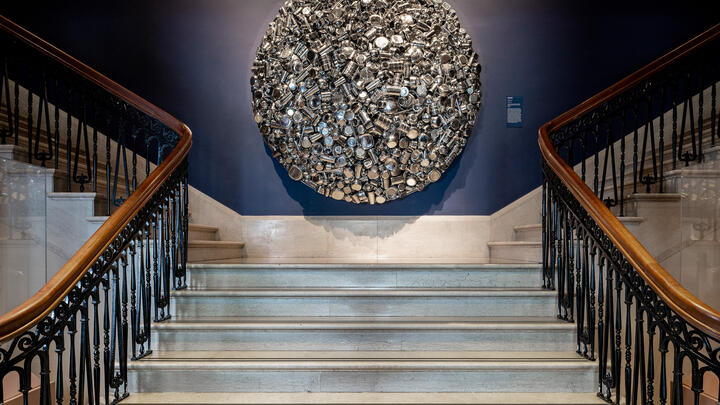
The MFAH is an encyclopedic museum; the classification means that it aims to present art from all cultures and eras—some 80,000 artworks across 5,000 years. The museum encompasses three buildings on a 14-acre campus, offering 300,000 square feet of gallery space, second only to New York’s Metropolitan Museum of Art among American museums. With an endowment of $1.8 billion, the museum is better-positioned for the future than nearly all of its peers. And thanks to a bequest from oil heiress Caroline Wiess Law, which directed half of her $450 million gift specifically to acquisitions of post-1900 art, the MFAH can pursue virtually any modern artwork it desires.
The growth of the museum reflects Houston’s character and history. Much of its prosperity traces directly to the Spindletop oilfields that transformed a railroad junction and cotton market into the global energy hub Houston has become. Petrochemical industries associated with the oil business have yielded many more donations.
But despite their scale, neither Houston nor the MFAH are typical tourist destinations. “When people go to New York, they go to the Met,” Bailey says. “They don’t go for the Ching Dynasty bronze exhibition. They go because it’s the Met.” He adds, “Houston isn’t really a tourist town. We have to work a little harder. We have to pull people repeatedly from the community.”
This reality drives an entrepreneurial approach. Curators and even the museum’s director regularly appear on local radio and television to promote exhibitions. Street banners catch the attention of passing drivers. The museum sees 900,000 annual visitors; 92% come from a 50-mile radius of the museum.
“Our competition isn’t really other museums; it’s other leisure activities,” Bailey notes. “Admission costs about the same as a film ticket, but people can spend the whole day. We get our biggest numbers in the summertime because it’s cool in the museum.”
The risk for an encyclopedic museum is that visiting can feel as exhaustive, and exhausting, as reading the 22 volumes of the World Book. But Houston-based art journalist Rainey Knudson says the MFAH makes its extensive collection exciting: “I have fun visiting the MFAH campus these days. The place feels optimistic and alive and deeply human.”
Anne Chao, a historian, philanthropist, and MFAH trustee, says the museum’s strengths are often overlooked: “It’s a very sophisticated museum with galleries that celebrate Chinese, Japanese, Korean, Indian, Islamic, and Latin American art.”



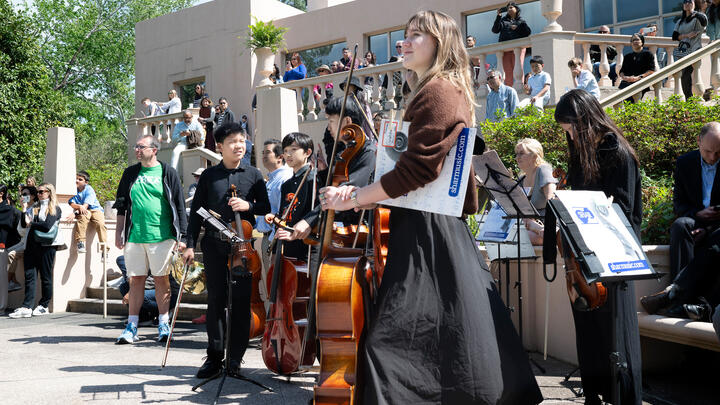

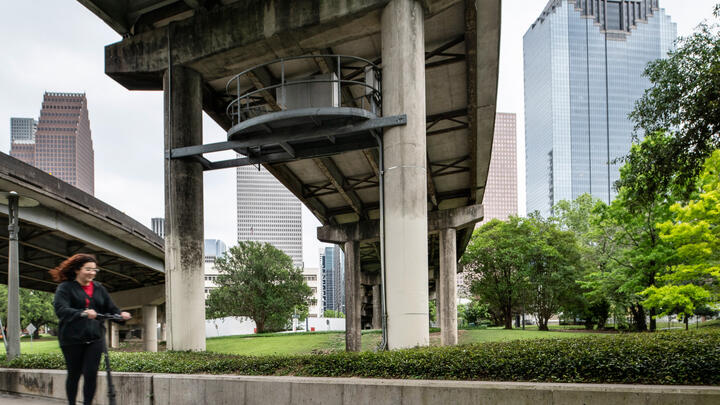
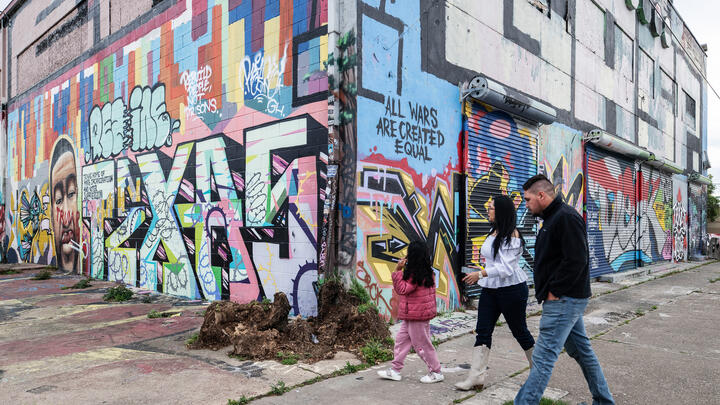
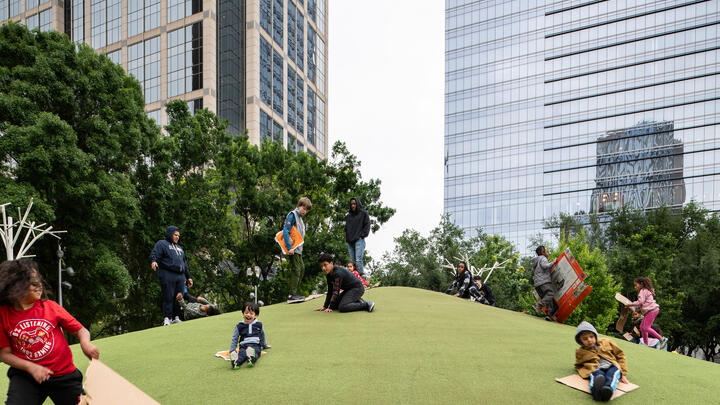
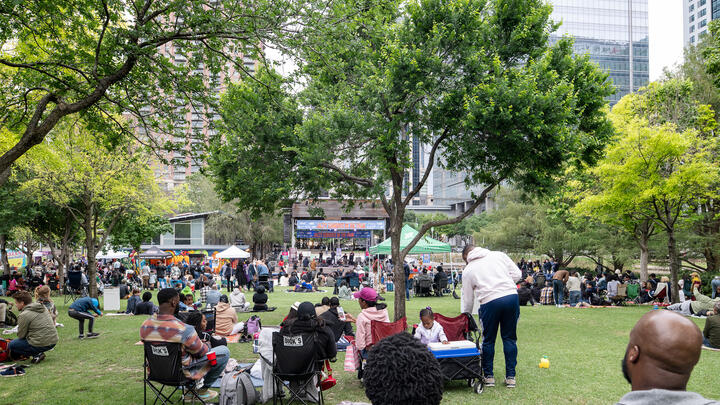
The museum’s vitality and cross-cultural collection reflect Houston itself—the second-most-diverse large city in America. The city boasts a vibrant food scene, featuring high-quality restaurants from dozens of cultures, as well as fusions that emerge from the many traditions that live side-by-side in Texas.
“These communities are so strong that they can really maintain cultural identities,” Bailey says. The resulting convergences are wonderful, he adds: “I loved having our Zen painting show up during the rodeo when everybody from Texas was in town. It was amazing to have Mennonites in prairie dresses looking at Buddhist paintings.” Or the moment when women in hijabs quizzed a Japanese architect as he assembled a popup cypress tea house for an event in a neighborhood park.
A museum becomes more vital when it connects with its home city in all of its diversity, Tinterow says. Sometimes museum staff initiate these connections; sometimes communities do. “We have one of the best presentations of Islamic art in the country,” he points out. That is because in 2004, members of multiple Muslim communities approached his predecessor. “They said, ‘Given 9/11 and what’s going on in the Middle East, we feel that people are suffering from a misapprehension of what Islam is and what Islamic culture has contributed to world civilization.’” Their funding pledge launched the Islamic Art Initiative, presenting Islamic art within the context of world art. New and expanded galleries focusing on Japanese, Korean, and Indian art have similarly emerged through collaboration between the museum and Houston’s expatriate and immigrant communities.
Houston is also home to a vibrant Zoroastrian community. This historically influential monotheistic religion, which predates Christianity and Islam, originated in Persia. Many Zoroastrians fled persecution to settle in India, where they are known as Parsis. Of the estimated 125,000 Zoroastrian adherents worldwide, about 1,100 live in Houston.
Immigrant Parsi families who gathered in Houston living rooms in the 1970s formed the Zoroastrian Association of Houston (ZAH), purchased land, built a library, a community center, and finally the only Zoroastrian temple in North America.
Aban Rustomji, a leader in Houston’s Zoroastrian community and the librarian at ZAH, recalls the moment when Bailey first saw the community’s archive. “His eyes lit up,” she says, as he recognized the potential for a museum exhibition. For Rustomji, both the collaborative process and the result were gratifying. “It’s a back-and-forth. You feel like you’re part of the museum and the success of the museum.” Once the exhibition opened, “It was just phenomenal. For the teenagers, it got them interested—‘Oh, we are in the museum’—which led to a sense of pride in their identity.”
And that’s part of the larger goal—that Houstonians come to see themselves reflected and encounter others in the process. The approach can come with frustrations, Bailey says; a new exhibition in the Korean gallery might be featured on the front page of all five Korean newspapers and get Koreans to the museum, while a write-up in the Houston Chronicle won’t necessarily break through to a non-Korean audience.
But as more communities see themselves represented while also encountering windows into other parts of Houston’s diverse cultural landscape, these experiences become woven into the city’s fabric. Chao, who has also been involved with an oral history of Asian immigrants at Rice University, observes, “You create little pockets of knowledge here and there and they all come together, little by little.”
She illustrates the gratifying impact of the intertwining of museum and community: “An Indian friend recently told me, ‘Every time I have people visiting from India, we stop at the museum. It’s part of our tour. We feel like it’s part of our home.’”
